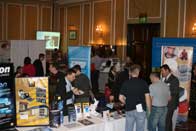At the start of a new CET point-gathering year, 493 delegates attended the largest three-day UK CET course - Eyecare 3000.
 The Glasgow conference was also underpinned by the support of 60 exhibitors displaying the newest products and technology. There were additional CET opportunities in the form of three multiple choice quizzes based on the presentations and mini-symposia, giving three extra CET points a day. This year also saw the introduction of plasma screens throughout the exhibition, allowing delegates to listen to the presentations over a coffee and still earn CET points.
The Glasgow conference was also underpinned by the support of 60 exhibitors displaying the newest products and technology. There were additional CET opportunities in the form of three multiple choice quizzes based on the presentations and mini-symposia, giving three extra CET points a day. This year also saw the introduction of plasma screens throughout the exhibition, allowing delegates to listen to the presentations over a coffee and still earn CET points.
Graphic start
Register now to continue reading
Thank you for visiting Optician Online. Register now to access up to 10 news and opinion articles a month.
Register
Already have an account? Sign in here
